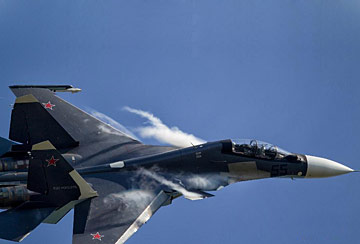Military experts are currently speculating on whether China's aircraft carrier may be equipped with unmanned combat air vehicles (UCAV). This has not only increased public interest in these new "robot fighters", but also led China's military devotees to wonder whether China's forthcoming self-developed aircraft carrier will similarly be equipped with shipborne UCAVs.
The technical threshold of the unmanned air vehicle is relatively low. A company that can manufacture sophisticated model aircraft has the technology to develop a UAV. However, the threshold of a UCAV is more than 10 times higher than that of a UAV. The combat capability of UCAV requires particular abilities in target identification and autonomous attack. Thus the requirements of the observing and targeting system (eyes), the control system (brain), and the communication system (mouth and ears) of a UCAV are very high. On the one hand, the UCAV should be able to detect the target that is to be attacked, while transmitting images to remote controllers; on the other hand, the UCAV should be able to receive remote directions based on human judgment, and then launch attacks or engage in combat under remote control.
Shipborne UAVs were not manufactured specifically for aircraft carriers. It is already the case that some advanced modern destroyers and surface vessels have been equipped with shipborne UAVs.
But the greater platform size of an aircraft carrier creates the opportunity for large-scale UAVs with combat and attack capabilities. However, this presents a technical difficulty - carrier-borne UCAVs need all the functions of ordinary UCAVs, but also require an independent capacity to take off from and land on aircraft carriers. The requirements of carrier-borne UCAVs include not only attack and combat capability, but also the delicate maneuvers of 'intelligent' aircraft.
 |
 Mexican president delivers first State of Nation address
Mexican president delivers first State of Nation address Highlights of MAKS 2013 Int'l Aviation and Space Show
Highlights of MAKS 2013 Int'l Aviation and Space Show  10th China-ASEAN Expo opens in Nanning
10th China-ASEAN Expo opens in Nanning Baby born to save his sister - the story of a savior sibling
Baby born to save his sister - the story of a savior sibling Lady of mystery: Female SWAT team in prison disclosed
Lady of mystery: Female SWAT team in prison disclosed  Single mother, baby live in KFC restaurant for months
Single mother, baby live in KFC restaurant for months Top 10 naked hotels in the world
Top 10 naked hotels in the world The most gorgeous Chinese women in the eyes of foreigners
The most gorgeous Chinese women in the eyes of foreigners A collection of bizarre rooftop buildings around China
A collection of bizarre rooftop buildings around China Putin intimate contacts with marine animals
Putin intimate contacts with marine animals China's frigate 'Bengbu'in fire training
China's frigate 'Bengbu'in fire training Fresh students 'forced' to register in university independently
Fresh students 'forced' to register in university independently 2013 Taiwan Int'l Tourism Expo kicks off in Taipei
2013 Taiwan Int'l Tourism Expo kicks off in Taipei Photo story: Take a gap year
Photo story: Take a gap year Nokia's Global Headquarters: visiting a declining empire
Nokia's Global Headquarters: visiting a declining empireDay|Week|Month